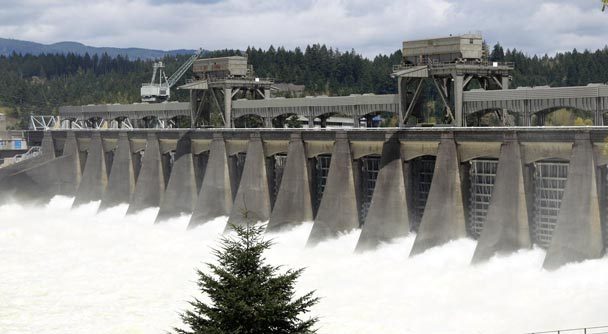forum
library
tutorial
contact

A Quick Guide to the
Salmon-Dam Debate
by Rocky Barker
Idaho Statesman, September 23, 2013
|
the film forum library tutorial contact |

|
A Quick Guide to the
by Rocky Barker
|
 The proposal by the U.S. Fish and Wildlife Service, tribal, state and other biologists to test higher spill -- water that doesn't go through power-generating turbines -- at the eight dams on the Columbia and Snake rivers is a continuation of a long debate among scientists.
The proposal by the U.S. Fish and Wildlife Service, tribal, state and other biologists to test higher spill -- water that doesn't go through power-generating turbines -- at the eight dams on the Columbia and Snake rivers is a continuation of a long debate among scientists.
So what are the biologists proposing? They want to see if increasing spill at the dams to a level that would increase the amount of dissolved nitrogen gas above current limits will increase survival of the migrating juveniles. They acknowledge that there is some risk that more fish will die, because higher nitrogen levels may give them the "bends" like divers get.
But the biologists believe the fish will quickly leave the pools below the dams before they suffer harm from the elevated nitrogen. With more salmon diverted from the hydro turbines, these scientists believe a higher percentage of salmon will leave the Columbia for the Pacific healthy.
If, as their models show, as many as 4 percent of the salmon and steelhead that spawn in Idaho and eastern Oregon and Washington return to spawn as adults, that could lead to the recovery of the wild stocks.
Since spilling the water over the dams also helps upper Columbia salmon and steelhead, it has more beneficial effect than breaching the four Snake dams in eastern Washington.
So why isn't the National Oceanic and Atmospheric Administration's Fisheries Service embracing this option? First, the federal agencies that operate and pay for the dam and salmon programs argue that the biological opinion -- the draft document released last week -- doesn't need to get the salmon to recovery under the federal Endangered Species Act. They say by law the goal is simply to offset the effects of the dams.
Second, their biologists have always disagreed with the tribal, state and U.S. Fish and Wildlife Service about the basic science. Back in the 1990s, when the Comparative Survival Study group began its work, it argued that the migration through the dams caused delayed mortality in salmon after they entered the Columbia estuary below Bonneville Dam near Portland, Ore. This applied to fish that were aided by spill and moved past the dams on barges.
The NOAA scientists, along with those for the U.S. Army Corps of Engineers, the Bonneville Power Administration and the University of Washington, disputed that assertion. But over the past 15 years, the evidence of delayed mortality became nearly indisputable.
That evidence showed that the delayed mortality is even higher for salmon that are collected in screens above the hydro turbines and barged downriver. This finding undercut the barge and collection system -- the major mitigation program at the dams -- that allowed more water to run through the turbines and generate electricity and revenue.
The dam managers came up with fish slides, a new technology that improved survival at lower flows of spill, which they now support. And their biologists argued that steelhead still do better in the barges, so they called for less spill and more barging in the late spring for steelhead.
They also believe there is too much risk in allowing nitrogen levels to rise above current limits.
What did U.S. District Judge James Redden do? He called for maximum spill, putting his weight behind the Comparative Survival Study scientists. Until this year, they'd argued that breaching the four dams was the best way to speed flows and juvenile salmon down the rivers and improve survival.
That doesn't seem as important now that record runs of fall chinook are swimming back to spawning grounds on the Columbia and Snake. But the run of fall chinook, which could reach 1 million adults, is due in part to cooler temperatures from upswelling currents in the Pacific Ocean that increase the zooplankton that young salmon eat and reduce the number of predators.
These conditions have largely existed since the late 1990s. In 1995, when ocean conditions favored predators and not zooplankton, fewer than 1 million salmon total returned, including spring, summer, fall chinook and sockeye.
There was very little water spilled over the dams intentionally in those days. As many salmon as possible were loaded onto barges.
These ocean conditions, scientists now recognize, are cyclical and it is just a matter of time until we and the salmon face them again.
But the scientific debate, fueled by federal agencies that can produce more money when they run more water through the hydro turbines, will continue.
learn more on topics covered in the film
see the video
read the script
learn the songs
discussion forum
